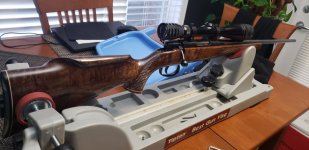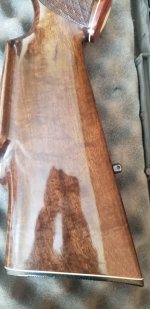I tried truoil on an old Cooey as practice, and I could never get a nice final coatI started doing it as a hobby 5 yrs ago. Pic is a 70s Anschutz that had some major dings and was my first effort with a new process. It helped having a beautiful piece of old European wood to work with.
You are using an out of date browser. It may not display this or other websites correctly.
You should upgrade or use an alternative browser.
You should upgrade or use an alternative browser.
A gunsmith for Refinishing the Wood Gun Stock
- Thread starter alberta.elk
- Start date
Your final coat should be wax. Tru Oil has its limiting factors, one being it dries very quickly if you don't cut it a bit. It's not a one application product either. Best results will be building it up in layers with very light sanding to remove any runs, bubbles, debris, etc. I polish mine 3x before the final step as well.I tried truoil on an old Cooey as practice, and I could never get a nice final coat
I don't gloss finish all. If I have more time and want the handrubbed oil satin finish then Tru oil never enters the picture.
I respectfully disagree. Tru-oil is capable of producing a top quality finish - high gloss or satin(matte) - whichever is desired. For best results, the wood surfaces should be as smooth and blemish-free as possible before applying the first coat. It generally takes 5 or more coats to get a final finish and each coat must be rubbed with 0000 steel wool between coats. This process eliminates small imperfections after every coat, rather than making them worse by piling additional coats over them. It also creates micro scratches in the finish that assist in properly bonding the successive layer. There is no grit of sandpaper fine enough to use on an oil finish, unless your goal is to remove it.Your final coat should be wax. Tru Oil has its limiting factors, one being it dries very quickly if you don't cut it a bit. It's not a one application product either. Best results will be building it up in layers with very light sanding to remove any runs, bubbles, debris, etc. I polish mine 3x before the final step as well.
I don't gloss finish all. If I have more time and want the handrubbed oil satin finish then Tru oil never enters the picture.
The Tru-oil must be applied using your fingers. It should be spread as thinly as possible. Great care should be taken to start on one side and spread the oil in overlapping sections the size of which are determined by how far the oil covers at minimal thickness. A minimum of 24 hours must be allowed between coats for proper curing. There should be no possibility of drips because the layer is far too thin to accumulate enough in one place to form a droplet.
Gun wax is useless IMHO, except perhaps for a bush fix to seal bare walnut due to a worn, scratched surface (and I'm not sure it's any good for that, either)
To the OP:
There are numerous other methodologies that should be part of this process. I've spent 20 years researching and experimenting to perfect the process. Aside from the shear volume of detail I would have to provide, I'm not about to share all that has been learned in an open forum. Since we both live in Edmonton, I'd be willing to show you how it's done, if you like. Contact me if you're interested.
I respectfully disagree. Tru-oil is capable of producing a top quality finish - high gloss or satin(matte) - whichever is desired. For best results, the wood surfaces should be as smooth and blemish-free as possible before applying the first coat. It generally takes 5 or more coats to get a final finish and each coat must be rubbed with 0000 steel wool between coats. This process eliminates small imperfections after every coat, rather than making them worse by piling additional coats over them. It also creates micro scratches in the finish that assist in properly bonding the successive layer. There is no grit of sandpaper fine enough to use on an oil finish, unless your goal is to remove it.
The Tru-oil must be applied using your fingers. It should be spread as thinly as possible. Great care should be taken to start on one side and spread the oil in overlapping sections the size of which are determined by how far the oil covers at minimal thickness. A minimum of 24 hours must be allowed between coats for proper curing. There should be no possibility of drips because the layer is far too thin to accumulate enough in one place to form a droplet.
Gun wax is useless IMHO, except perhaps for a bush fix to seal bare walnut due to a worn, scratched surface (and I'm not sure it's any good for that, either)
To the OP:
There are numerous other methodologies that should be part of this process. I've spent 20 years researching and experimenting to perfect the process. Aside from the shear volume of detail I would have to provide, I'm not about to share all that has been learned in an open forum. Since we both live in Edmonton, I'd be willing to show you how it's done, if you like. Contact me if you're interested.
- Location
- Edmonton AB
I'm a journeyman auto body techHello everyone,
Who do you recommend for refinishing a wood gun stock?
Regards,
Alberta.elk
I actually used automotive urethane clear coat to refinish this one. That was 10 years ago.
I cleared it, sanded, cleared sanded 5 times. It's a beautiful indestructible stock now.
The pictures do not do it justice
Attachments
We aren't really disagreeing. I said the Tru Oil isn't the one and only step. It requires tweeking its applied. Of course every stock refinisher has their own idea of what level is satisfactory, and I've seen lots of really bad ones as I'm sure you have. My process is 1.)After lots of prep work, removing original finish down to bare wood, light sanding and taking care of dings etc, tack cloth to remove dust then its Tru Oil time. 2.) 5-10 thin coats 24 -48 hours apart of Tru Oil applied by finger, (I cut mine slightly to thin it a bit and to keep it from setting up and getting tacky quickly - which it does vs using an oil like BOL or Tongue 3.) Very light brushing with 0000 steel wool after the sit time to remove imperfections in hardened oil and to create a slight haze 4) as mentioned before 5-10 repeats depending on individual taste 5) 3 step polish process I won't disclose 6) a wax application and buff. Like you I'm not going to give away all of my process.
Attachments
try Danish Oil , Watco is one brand . The easiest refinish you will ever do. Wet the stock with whatever colour of Danish Oil you prefer , keep it wet for about 15 min with a sponge paint brush , then , using an old T-Shirt , wipe it all off, yep , wipe it all off , keep checking to see if any bleeds out of some spots. Let it dry at least 24 hrs, give it a rub with some ultra fine steel wool and repeat the above process. The Danish oil hardens in the wood , not on it. Seals the wood and gives protection from moisture. Each coat will bring a bit more of the grain out each time. And the best part is you can’t screw it up, no runs , no blotch’s . I have used this for many years and anyone I have told and trued it says they will never use anything else. Do not throw the wet T-shirt in the garbage until it is completely dry, as with any oil product , can combust if left wet and bunched up.
Fyi straight..in my original reply I was only saying a coat or coats of Tru Oil without prep and finish work will make for a "shiny on the surface" result that some guys think is just fine. And that Tru Oil on its own is not going to give similar results to processes like you and I are talking. Cheers.I respectfully disagree. Tru-oil is capable of producing a top quality finish - high gloss or satin(matte) - whichever is desired. For best results, the wood surfaces should be as smooth and blemish-free as possible before applying the first coat. It generally takes 5 or more coats to get a final finish and each coat must be rubbed with 0000 steel wool between coats. This process eliminates small imperfections after every coat, rather than making them worse by piling additional coats over them. It also creates micro scratches in the finish that assist in properly bonding the successive layer. There is no grit of sandpaper fine enough to use on an oil finish, unless your goal is to remove it.
The Tru-oil must be applied using your fingers. It should be spread as thinly as possible. Great care should be taken to start on one side and spread the oil in overlapping sections the size of which are determined by how far the oil covers at minimal thickness. A minimum of 24 hours must be allowed between coats for proper curing. There should be no possibility of drips because the layer is far too thin to accumulate enough in one place to form a droplet.
Gun wax is useless IMHO, except perhaps for a bush fix to seal bare walnut due to a worn, scratched surface (and I'm not sure it's any good for that, either)
To the OP:
There are numerous other methodologies that should be part of this process. I've spent 20 years researching and experimenting to perfect the process. Aside from the shear volume of detail I would have to provide, I'm not about to share all that has been learned in an open forum. Since we both live in Edmonton, I'd be willing to show you how it's done, if you like. Contact me if you're interested.
I've done several that way as well depending on what I think will look best on what rifle and the quality of the wood underneath that factory finish. I'm also a big fan of matte finish stocks for many reasons, but there's older rifles with amazing walnut that I just felt should POP and a gloss finish will def make that happen. For sure Tru Oil is a quicker way to get to the end result with the minimal dry times vs the previously mentioned oils. It doesn't have to stay super glossy either. Easy to tone that down.Your final coat should be wax. Tru Oil has its limiting factors, one being it dries very quickly if you don't cut it a bit. It's not a one application product either. Best results will be building it up in layers with very light sanding to remove any runs, bubbles, debris, etc. I polish mine 3x before the final step as well.
I don't gloss finish all. If I have more time and want the handrubbed oil satin finish then Tru oil never enters the picture.
Absolutely. Matte finishes appear more "original" on most stocks and they wear better because they don't show scuffing and minor abrasions as easily. However, as you say, highly figured walnut and walnut with beautiful mineralizations and/or "tiger striping" demand a gloss finish to properly showcase these features and create the 3D depth effect.I've done several that way as well depending on what I think will look best on what rifle and the quality of the wood underneath that factory finish. I'm also a big fan of matte finish stocks for many reasons, but there's older rifles with amazing walnut that I just felt should POP and a gloss finish will def make that happen. For sure Tru Oil is a quicker way to get to the end result with the minimal dry times vs the previously mentioned oils. It doesn't have to stay super glossy either. Easy to tone that down.
100% straight. The older euros look particularly good glossy when that old growth walnut pops. Theres something about a schnabel forend that does it for me too. CZ, Anschutz, Sauer etc can be mind blowing. Too beautiful to hunt sometimes.Absolutely. Matte finishes appear more "original" on most stocks and they wear better because they don't show scuffing and minor abrasions as easily. However, as you say, highly figured walnut and walnut with beautiful mineralizations and/or "tiger striping" demand a gloss finish to properly showcase these features and create the 3D depth effect.
I haven't used true oil much but a beginner can achieve a satisfactory result quite easily. I learned that the first one or 2 coats are forgiving, then the 3rd coat should be thinned because otherwise it dries too fast and affects the underlying layer. But I prefer a fast drying finish because I am impatient, haha. I did a SKS the other day and it looks like factory shellac. I did not sand out the markings and left the bumps alone. As dye I just use leather dye from amazon, they have many colours available.
Last edited:












































































